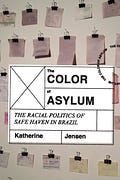Refuge and race
The Color of Asylum: The Racial Politics of Safe Haven in Brazil, Katherine Jensen, reviewed by Gavin O'Toole
The Color of Asylum: The Racial Politics of Safe Haven in Brazil, Katherine Jensen, 2023, The University of Chicago Press
It is the truth that nations dare not speak when they open their arms with such public fanfare to the world’s wretched: asylum is clearly not colour blind.
This has obviously been the case in countries like the UK where, in a climate in which immigration has become a political bone of contention, some asylum seekers have been much more welcome than others.
Ukrainians and Hongkongers, for example, have largely been treated as special guests, while refugees from Africa and the Middle East are forced to board leaking boats in order to arrive as third-class exiles.
The merit of Katherine Jensen’s book is that it exposes this harsh truth for what, essentially, it is—racism at the point of entry, which then reinforces pre-existing racialised hierarchies in a given society.
Her focus is Brazil, often regarded as an exemplar of refugee protection and a model for Latin America and beyond. The country is recognised as operating such fair and open policies that on average it acknowledges over 90 percent of asylum seekers as refugees.
Just ask the Syrians who fled US-sponsored violence in the Middle East en masse. While many countries denied them access, Brazil flung open its doors in 2013 with the result that, within a year, Syrians went from a marginal refugee community in the country to its largest.
Yet Jensen points out that this belies the hidden story of racialisation in Brazil, one that became clear to the author during the Syrian diaspora.
Prior to that, most asylum seekers and refugees arriving in the country were African—mainly from the Democratic Republic of the Congo—and their experiences before, during, and after applying for asylum diverged considerably from their Syrian peers.
In this particular case, a key reason for that is the status of Arabness in Brazil, where being Arab represents a premium, offering a guaranteed transition into “whiteness” in a majority black and brown country.
This is in no small measure because in Brazil Arabs are associated with economic acumen and entrepreneurship, an exalted immigrant group whose descendants figure prominently among their new country’s political and economic elites.
As Jensen writes: “While Arabs are sociopolitically marginalized and denigrated in the United States—as foreign racial others, terrorists, and threats to the nation—such racial discourses do not resonate in Brazil.
“Instead, Arabness is celebrated. Those of Middle Eastern descent have trended into whiteness in that majority black and brown country, and they have obtained a privileged economic, political, and cultural presence in the nation in Brazil.”
In practice, the author argues, this meant that the asylum process was “radically reconfigured” actively by the state in favour of Syrians, who were provided “multiple concessions” that facilitated their immigration.
In short, says Jensen, Brazilian officials view and treat Syrians as credible, legitimate refugees who belong in the country whereas, by contrast, Congolese asylum claims are treated with suspicion, subject to increased scrutiny, and often slowed down.
The author writes: “Anti-black racism shapes the experiences of Congolese and other African refugees and entrenches racial inequalities—even among those the state deems worthy of legal protection. This leads them to feel very differently about Brazil and their place in it.”
The experiences of Congolese refugees, notes Jensen, expose how legal inclusion can also be underwritten by racial subordination. The Color of Asylum shows how refugees are understood through racial ideologies of sociopolitical worth, shaping the meanings of membership in their new nation.
It is an issue that extends far beyond Brazil and that we must consider closer to home. Forced displacement worldwide now affects approximately 100 million people, and in 2021 there were 4.6 million pending asylum claims globally.
This book follows processes of asylum for forced migrants to expose how the Brazilian state racialises those seeking safe haven, resulting in familiar inequalities often hidden behind a “smoke screen of formally inclusive policies”.
Jensen makes an essential contribution to urgent debates far beyond Latin America about how we treat migrants and how even the global good of asylum is politicised and racialised in subtle ways that reproduce discrimination.
She offers sobering food for thought for politicians who feed off popular ignorance about immigration, and states that do not address the inequalities that asylum itself can perpetuate.
The author writes: “Asylum generates racialized political violence, veiling the domination entailed for both those included and excluded, while presenting the state as benevolent.
“By assuming few migrants deserve such protection, we make unrecognizable the suffering produced among those who receive it (by presuming it is, indeed, a protection), and normalize that to which those migrants excluded, deemed unworthy and undeserving of asylum, are subjected.”


